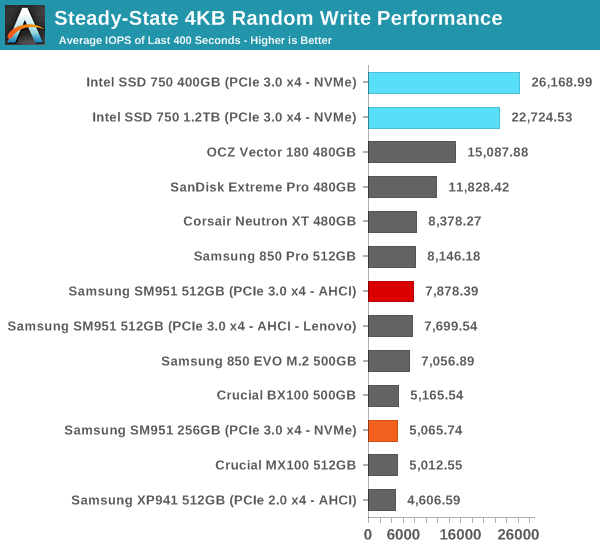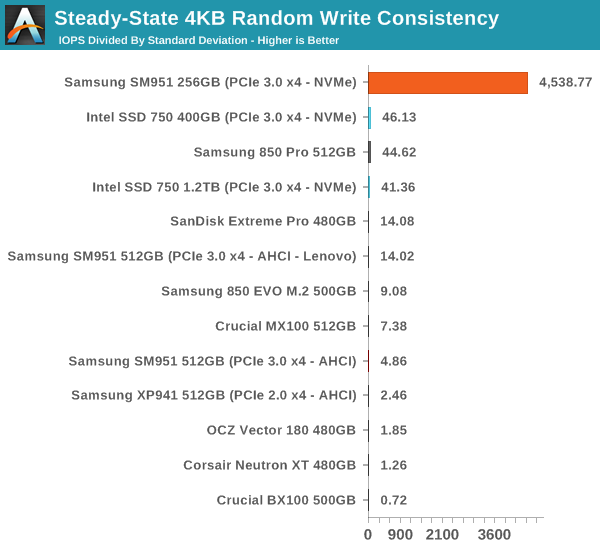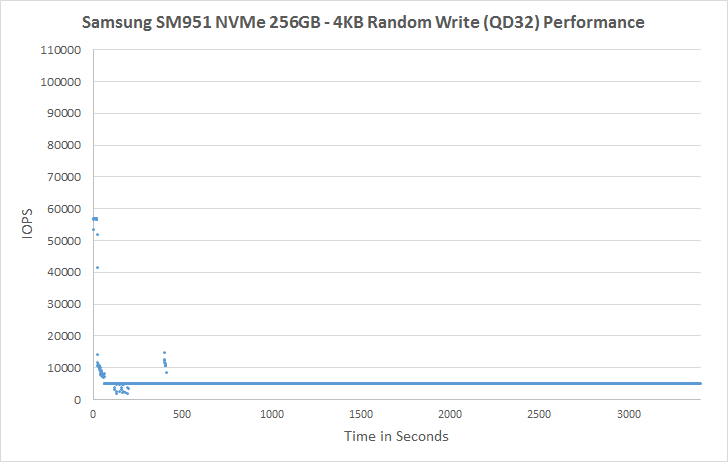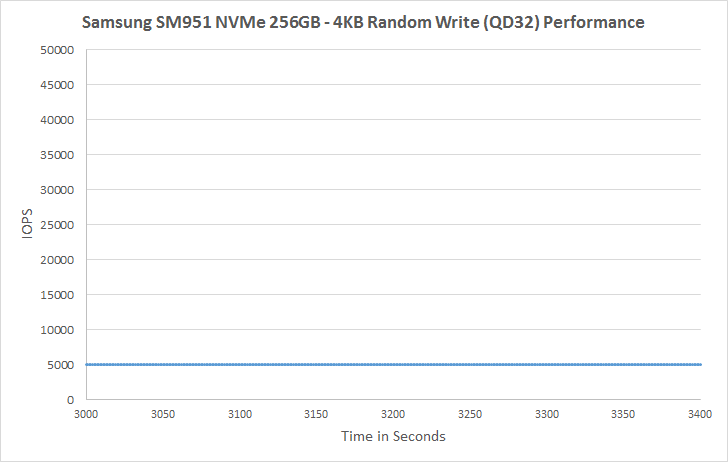Samsung SM951-NVMe (256GB) PCIe SSD Review
by Kristian Vättö on June 25, 2015 9:40 AM ESTPerformance Consistency
We've been looking at performance consistency since the Intel SSD DC S3700 review in late 2012 and it has become one of the cornerstones of our SSD reviews. Back in the days many SSD vendors were only focusing on high peak performance, which unfortunately came at the cost of sustained performance. In other words, the drives would push high IOPS in certain synthetic scenarios to provide nice marketing numbers, but as soon as you pushed the drive for more than a few minutes you could easily run into hiccups caused by poor performance consistency.
Once we started exploring IO consistency, nearly all SSD manufacturers made a move to improve consistency and for the 2015 suite, I haven't made any significant changes to the methodology we use to test IO consistency. The biggest change is the move from VDBench to Iometer 1.1.0 as the benchmarking software and I've also extended the test from 2000 seconds to a full hour to ensure that all drives hit steady-state during the test.
For better readability, I now provide bar graphs with the first one being an average IOPS of the last 400 seconds and the second graph displaying the standard deviation during the same period. Average IOPS provides a quick look into overall performance, but it can easily hide bad consistency, so looking at standard deviation is necessary for a complete look into consistency.
I'm still providing the same scatter graphs too, of course. However, I decided to dump the logarithmic graphs and go linear-only since logarithmic graphs aren't as accurate and can be hard to interpret for those who aren't familiar with them. I provide two graphs: one that includes the whole duration of the test and another that focuses on the last 400 seconds of the test to get a better scope into steady-state performance.

Steady-state performance isn't mind blowing, although it's a little unfair to compare the 256GB SM951-NVMe against a 512GB SM951-AHCI because available NAND throughput can play a major role in steady-state performance with a properly designed controller and firmware.

The mediocre steady-state performance is replaced by outstanding consistency, though. During the last 400 seconds, the SM951-NVMe has standard deviation of only 1.12, whereas the next drives are in the order of hundreds with many drives surpassing 1,000.
 |
|||||||||
| Default | |||||||||
As there's practically no variation in performance, the graph is just a straight line after the initial cliff. There are zero up and down swings, which is something I've yet to see even in an enterprise SSD. Samsung has always done well in IO consistency, but in all honesty the SM951-NVMe sets a new bar for consistency. On the downside, I would rather take some variation with higher performance because especially for client workloads such level of consistency isn't really needed, but increased performance can always help with intensive IO workloads. Nevertheless, I'm very happy with the direction Samsung is taking because we still see some controller vendors not paying enough attention to consistency, but it's clearly a high priority for Samsung.
Unfortunately I couldn't run any tests with added over-provisioning because the hdparm commands I use for limiting the capacity do not work with NVMe drives. There are similar commands for NVMe drives too, but for now there is no publicly available utility for issuing those commands.
 |
|||||||||
| Default | |||||||||










74 Comments
View All Comments
Dasa2 - Monday, June 29, 2015 - link
i would also like to know how cpu usage is affectedit may not be of any significance with a 4790k but with a i3\i5nuc?
i would also be interested to see if ram speed has any effect on such high speed ssd speed in a nuc since most people seem to buy 1600c11 sodimm for them
iwod - Thursday, June 25, 2015 - link
What is stopping us to getting a 32 Channel SSD Controller?Cost? Or we wait for 3D NAND to push to the max 3.2GB/s a PIC-E 3.0 x4 allows?
What's next then? PCI-E 4.0 isn't even on the Cannonlake Roadmap.
And even with the 4x PCI-E 4.0 it seems to be too little headroom for SSD.
Where is the next bottleneck?
Kristian Vättö - Friday, June 26, 2015 - link
There are some 32-channel controllers in the enterprise space, but as you suspected the reason why we don't see those in the client market is cost.Right now I would say the biggest bottleneck is software design because everything (except some enterprise applications) is still designed for high latency storage (i.e. load everything to RAM and as little disk access as possible, whereas by properly utilizing the low latency of SSDs applications performance could be improved.
stevae - Friday, June 26, 2015 - link
OK, so a couple of things here. first, while windows 10 10130 is still a little buggy, i already have 10147 and it is rock solid. many improvements. next, i am running it on a samsung 951. boots very nice, there is no more error when restarting like there was in 10130, and things are smooth. however, it doesn't run at full speed. on crystal disk mark i get 1569 sequential read, and 1474 sequential write. and my sm951 is the ahci version. but this leads me to the BIG quesiton, since you guys said that the hardware is the same between the ahci and nvme versions, does that mean when the nvme version comes out and is sold widely, that i can download firmware to turn my ahci version into a nvme version?yeeeeman - Friday, June 26, 2015 - link
These SSDs are good for driving the performance up, especially for datacenters. In home usage, I swear that a Samsung 840 PRO is gonna satisfy all your hidden performance dreams. Period.JKJK - Friday, June 26, 2015 - link
You really didn't get the low-queue-depth-performance-and-low-latency-for-client-workloads-part, did you?I'm going to get me a few of these, as soon as they're available.
Shinzon - Friday, June 26, 2015 - link
I just build new main desktop and added also a 951 AHCI version and the difference from my 840 pro to this is very noticeable, almost as from mechanic drive to a SSD all over again. I can even feel the difference from the 951 and to my 2 840 pros in raid 0. So that comment is not very professional :-)Shinzon - Friday, June 26, 2015 - link
@ Kristian VättöAs someone else already speculated, could we please research some more if the AHCI version can be re flashed to NVMe version ? Of course Samsung answer will be: not supported because it's OEM product, warranty void and the whole swada but I guess it's a question of getting a flash program that supports the controller EPROM they use and copy the NVMe firmware and then reflash the AHCI version. I think many would be interested in this.
Tack för dina altid fina reviews :-)
dcaxax - Friday, June 26, 2015 - link
Two words about Samsung SSD's. Never. Again.stevae - Friday, June 26, 2015 - link
yeah, why would you. they only lead the ssd world 95% of the time. sure, you go ahead and stick with that ocz crap.